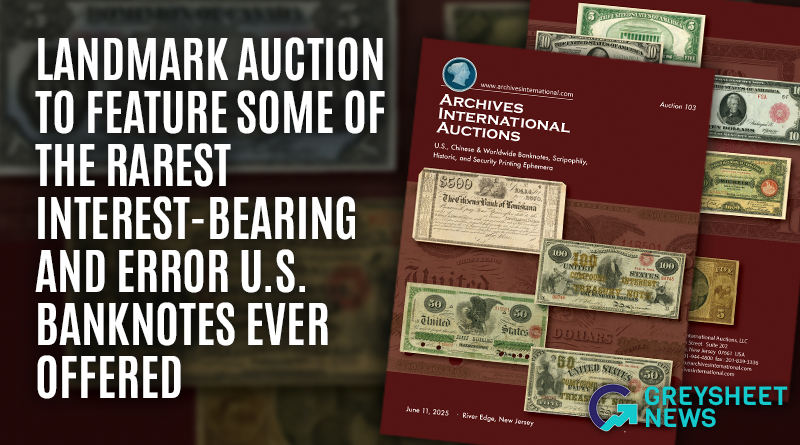AU58-MS62: Four Grade Points Comprise One Important Part Of The Market
There may be 70 points on the Sheldon numerical grading scale, but there are a certain few grading thresholds that represent significant areas of the market. For early type coins, that may be the grades of G4 and F12, while for moderns MS/PR67 and MS/PR70 generally hold the greatest importance. Yet, for the bulk of commonly traded United States coins there is a tight spectrum of four grade points that present its own unique set of challenges and trading opportunities.
There may be 70 points on the Sheldon numerical grading scale, but there are a certain few grading thresholds that represent significant areas of the market. For early type coins, that may be the grades of G4 and F12, while for moderns MS/PR67 and MS/PR70 generally hold the greatest importance. Yet, for the bulk of commonly traded United States coins there is a tight spectrum of four grade points that present its own unique set of challenges and trading opportunities. Coins grading AU58 through MS62 represent a major spectrum of the active marketplace. Many of the coin dealers who read this publication devote a large segment of their inventories to this critical segment of material. This is true for several reasons, with the most dominant factors being the intersectionality of quality and affordability benefitting both coin dealers and the collectors they serve.
As for how these grades play into the data reflected in the Greysheet, the AU58 through MS62 grades represent a very nuanced area of the hobby. For us, collecting this bid and sale data from the marketplace and reporting this information requires a degree of finesse. This is in part because of the very tight spread in price between these grades, particularly in the cases of the MS60 through MS62 prices. Meanwhile, the grade point of AU59 is a grade that exists only in theory but virtually never in practice and thus will not be discussed in this article.
Indeed, AU58 is the highest whole grade awarded by the major TPGs to circulated coins, with AU58+ bestowed upon especially nice AU58s that are but a light rub away from receiving a technical Mint State grade. Many folks will pay heavy premiums over AU58 prices to obtain an AU58+. In registry sets, the inclusion of AU58+ coins can help lift the average score for a collection, helping it rank substantially higher in comparison to other registry sets. In fact, PCGS even launched a series of registry sets in 2009 called “Everyman Collections” in which no coin may grade higher than AU58. The Everyman Collections encompass a variety of series ranging from half cents through pre-1933 gold coins, thus driving up demand for numerous types of coins slabbed as AU58s.
Then there’s the matter of some AU58s looking better than low-end MS coins. In fact, this is quite common. While the technical factor of wear – either its absence or presence – makes or breaks the qualifications of a coin grading “MS,” there are countless occasions when an AU58 coin may actually have more vibrant mint luster and overall better eye appeal than a dull, pockmarked MS60, MS61, or MS62. In the industry we see this all of the time. But what’s a dealer to do in pricing such pieces? Should it be that AU58s are prices higher, on a case-by-case scenario, than a worse-looking MS62?
These and other matters deserve some clarification. To that end, industry experts Tom Caldwell, president of Northeast Numismatics and Liz Coggan, founder of Elizabeth Coggan Numismatics, LLC, offer their professional opinions on the particulars of this most complex area of coin grading and why the AU58 through MS62 grade threshold is so important to understand in terms of pricing.
Liz Coggan, whose experience in the hobby spans more than 35 years, has seen the AU58-MS62 market mature over the past decades. In the early 1980s, intermediate grades such as AU58, MS61, and MS62 were just coming into widespread usage. Today, it’s hard to envision the marketplace without these grade points. “These grades cover an important portion of the coin marketplace – the MS60 to MS62 grade ranges are more affordable and present an entry point for a collector wanting to do an uncirculated set of a particular series but is unable to afford an MS63 or finer example,” says Coggan.
Meanwhile, she says AU58 coins have taken on their own critical role in the marketplace. “The AU58 grade has taken on tremendous importance for collectors assembling what are referred to at PCGS as Everyman registry sets, as AU58 represents the highest-available grade in the circulated grade range, thus making it highly sought after. There has been an explosion in prices for AU58 third-party graded material over the past several years. Additionally, AU58-graded material tends to be very aesthetically pleasing in terms of surface quality and luster.”
And AU58 coins maintain their audience for good reason. As noted, many of these coins look better and exhibit generally better eye-appeal than low-end MS coins, which are often riddled with bag mark, scratches, and discoloration – all detractions that are permitted within the widely accepted standards of that grade range. “AU58-graded coins tend to have what I refer to a cabinet friction from being housed in the old coin cabinets of bygone days which were velvet lined or felt-lined trays that the coins were placed on loosely without a flip to protect it,” she says.
Cabinet friction, a term deriving from the days of storing coins in coin cabinets, best describes coins that may have actually been stored in coin cabinets, which were a popular method for coin storage before the 1930s, when the widespread introduction of coin boards, folders, and albums changed the way hobbyists stored and organized their collections. Cabinet friction, presented as a sign on rub on the very highest points of the design, would have been imparted on the coin as the drawer was opened and the coin slid back and forth upon the velvet or felt. “Light breaks in luster are generally created by this, as is rub on the high points of the coin, thus taking it out of a Mint State grade classification, but not creating the unsightly bag marks and contact marks generally encountered on low-grade MS60- through MS62-graded pieces,” explains Coggan. “Therefore, AU58-graded coins tend to have a ton of eye appeal, very few abrasions, and sharp technical merits for strike.”
But what’s a dealer to do when pricing an AU58 coin that looks miles better than, say, an MS60, 61, or 62? Should these pretty AU58s sell for more than their higher-graded, but decidedly uglier, counterparts. “Absolutely!” exclaims Coggan. “I believe they should, and auction prices support the argument, regularly, across every series. In fact, I asked the editors of the Red Book if they would remove MS60 prices and replace them with AU58,” she adds. “If you look at auction data and the coins being graded at PCGS and NGC, there are relatively few MS60-graded coins being made, and thus sold. In my mind, AU58 is a much more important grade in the overall scheme of things regarding price data and actual activity of coins sold for the grade.”
Ultimately, regardless of the price factor, dealers need to accurately determine the grades of their coins, and this isn’t always easy to do, especially when the difference between an AU58 and an MS60 is a whiff of rub or a slight break in luster. This grade determination can be made all the harder when grading coins notorious for being weakly struck. “I believe one important factor to help someone understand the difference between rub and a weak strike is to familiarize themselves with what a weak strike or a coin struck from worn dies looks like,” suggests Coggan. “A coin can look heavily worn but truly be MS62 because it happens to be a date or mint that comes weakly struck. There is also the issue of seeing what may appear to be small contact marks which, in reality, is just light chatter or abrasion on the planchet prior to striking that is not concealed by design element details because the striking was poor,” she adds.
While it’s possible for any dealer to pick up on the striking characteristics across a wide variety of series, it’s something that may come more quickly to those who specialize in a certain series or at least within tight range of series. “Understanding how coins are made is important to accurately grading a coin,” Coggan asserts. “I would take the time to research what series tend to come with weak strikes and which branch mints had the biggest issues and in what eras. For example, Lincoln cents and Buffalo nickels struck in San Francisco and Denver can tend to come with mushy strikes if they were coined in the early to mid ‘20s.” Coggan says one way to familiarize yourself with the mechanics of minting would be to simply see how coins are made. “A trip to one of the United States Mint locations is ideal for anyone wanting to learn about the manufacture of coins. Seeing how they are made really can give a good visual to what I have described.” Both the Philadelphia Mint and Denver Mint are open to the public for free, with the Philadelphia Mint visitors access for self-guided tours and the Denver Mint providing guided tours on a scheduled basis.
After visiting a United States Mint facility and seeing coins struck before your very eyes you may indeed have a better appreciation for and understanding of the mechanics behind the way a coin is struck. Still, there are many challenges to be overcome when grading coins in the AU58 to MS62 range – something Coggan says can be less complicated when approaching the grading of these coins more systematically. “Two things need to occur to simplify the grading of these grades. The first is to determine, based on what I outline above, whether a coin is truly circulated or not. Once that is determined, then the only other criteria you need to address is contact marks – severity of quantity and where they are placed – and luster for determining which Mint State grade it is, so MS60, 61, 62, etc.”
She also adds you should always go for eye appeal over technical or numeric grade. “Everyone likes a pretty coin. Most people are buying the coin, not an assigned grade on a holder,” she notes. “I prefer AU58 over any of the low-end Mint State grades, just because nine out of 10 times they are more attractive.” She tells her fellow coin dealers that a market exists for coins in all the grades within the high-end circulated to low-end Mint State range. “This is particularly so for low-end Mint State when it comes to Walkers, silver dollars, and gold coins. These low-grade Mint State grades make sense, as the coins were transported in ways that would cause them to bang into one another when jostled, thus creating the bag marks that account for MS60 to 62 grades.” Larger, heavier coins indeed are more susceptible to detractions caused by jostling just due to the basic laws of physics, whereas small or lighter coins were less likely to receive such bangs and bruises in mint bags. “I think realistically, for the most part, MS60 to MS62 hardly applies to smaller coins.”
Of course, historically, making minute distinctions between one Mint State grade point or another wasn’t even a problem, as numerical grading of uncirculated coins was less important in an earlier era and intermediate grades such as MS61 and MS62 were all but unheard of. As Coggan recounts, in the “old days,” adjectival grading ruled. “If you think back to when the grading standards were created and there were only Brilliant, Choice, and Gem categories for Mint State examples, Brilliant Uncirculated covered a much broader spectrum than it does today – it probably encompassed MS60 to 63 grades; with Choice being today’s MS64 or 65 and Gem being all the grades above – MS66 to 68.” For younger dealers such simplistic grading standards may seem fanciful at best. For older dealers, grading terms such as BU, Choice, and Gem seem to become scarcer and scarcer in day-to-day industry parlance and hearken to a period that is most likely gone forever.
Tom Caldwell remembers a time when AU58s were more often than not dubbed “Sliders,” and uncirculated coins were commonly labeled and traded as “BU,” “Choice,” and “Gem.” He’s been a dealer since the relatively simpler “golden era” of the hobby in the 1960s. Yet, despite the complicated evolution of grading terminology and vernacular, Caldwell says coins in high-end circulated and low-end Mint States grades have achieved more and more demand over the years. “Coins in this grade range have increasingly become more popular for many reasons, among them the simple fact of economics that they are more affordable, allowing a greater audience to be able to afford.” He goes on to say that examples in that grade spectrum are not necessarily pursued by high-end collectors or those who are primarily concerned with investment. “Therefore, these pieces in general are not subject to price swings and are more stable.”
Along with the increased popularity of the lower-end MS coins, Caldwell notes AU58 coins have seen a huge uptick in desirability. “The AU58 grade in particular shows extreme demand in many series for several reasons. The registry set aspect has made this numerical grade popular as collectors find it elusive, in many cases especially attractive specimens are pushing prices as the competition aspect comes into play.” He notes that, in many cases, AU58s are relatively scarce for the simple reason that once a coin entered circulation, it saw heavy use for a period of months or years. “To find a coin in this grade range you need a coin that either barely saw circulation or has what amounts to the old term ‘cabinet friction,’ and this can be tough to find.”
The Massachusetts dealer says AU58s can look better than their MS60, 61, or 62 counterparts, but not always necessarily because of superior surface quality. “Yes, coins in these grades can look more appealing for the simple fact to the untrained eye, those not so keen on technical grading, they appear to be much better value for a fraction of the price.” Thus, dealers have great incentive to sell AU58 coins, especially to collectors who desire nice coins but don’t have the funds to support buying truly uncirculated coins. “If you are a collector, you might be of the mindset to ‘fill a hole’ with an attractive specimen that few will argue is correctly graded.”
And what about MS60 coins? “60 coins do not exist,” Caldwell claims. “Of course, this makes no sense, but soon after the grading services started over 30 years ago there was the need to pinpoint numerical grades,” he explains. “No longer were adjectives good enough. As a result, the grade 60 and in many series surrounding grades suffered.” Indeed population reports bear this out, with virtually countless issues showing higher pops for AU55s, AU58, MS61s, and MS62s than for MS60s. “You will find this to be the toughest one to locate in a PCGS or NGC holder. The grading services had to make determinations on how to grade a respectable-looking coin that looks decent having a little friction,” he says. “Sometimes 58 won out, sometimes 61 or 62. However, except in rare circumstances with a heavily bagmarked piece that technically graded Mint State, seldom did a coin get 60 as the certified grade.”
He says that in many cases AU58 coins do sell for more than those grading 60 or 61 due to eye appeal. “Again, it could be as a result of the registry competition or due to a coin that ends up in a 60 or 61 holder that may have excessive bag marks, meaning the desirability is less.” Caldwell says graders face many challenges when grading coins in this grade range and deciding what grade is appropriate, as far as being market acceptable. “Meaning that, sometimes, a technical grade may be, say AU 58, but the market and the grading services accept X coin as a Mint State coin. It’s just the reality of graded coins today and what was once a dirty little secret that is now readily accepted and talked about that the grading services in many cases grade any given coin higher today than in the past.”
He says learning how to grade coins in that grade range doesn’t necessarily present any more challenges than in the learning curve associated with grading lower-end circulated pieces or high-end Mint State material. “You just have to gain experience — the more you see, the more you should have a clue as to grades. The ANA week-long summer seminars and mini seminars at regional shows throughout the year can be invaluable at immersing yourself into grading and picking up valuable tips.”

Download the Greysheet app for access to pricing, news, events and your subscriptions.
Subscribe Now.

Subscribe to The Greysheet for the industry's most respected pricing and to read more articles just like this.
Source: CDN Publishing
Related Stories (powered by Greysheet News)
View all news
This sale presents an unprecedented opportunity for collectors to acquire museum-worthy examples from the nation's most pivotal monetary periods.

This relatively strong performance falls right between the prior two editions of this sale.

Greysheet Market Reports are the best way to stay current way on rare coin and paper money market info.









Please sign in or register to leave a comment.
Your identity will be restricted to first name/last initial, or a user ID you create.
Comment
Comments